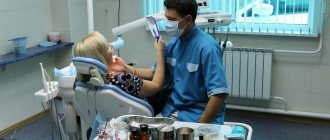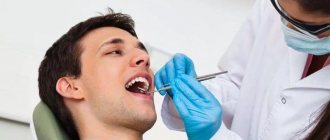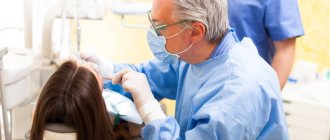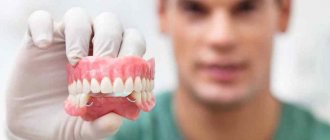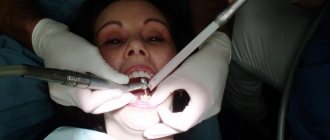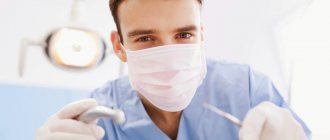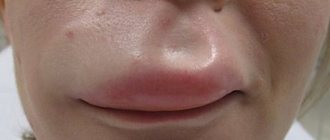Unbearable toothache, sore gums and bad breath require urgent attention from a dentist so as not to aggravate an existing problem.
The initial appointment is carried out by dental therapists. This is a sought-after specialization, since these doctors treat common pathologies of the gums, teeth and oral tissues. A general dentist has a broader range of expertise than a highly specialized orthodontist or surgeon. Such dentists eliminate periodontitis and periodontal disease, relieve pathological changes in the functioning of the salivary glands, treat cheilitis and glossitis (inflammation of the lips and tongue)
A dental therapist not only fills root canals, treats gums or removes tartar. A dentist works to study problems in the maxillofacial area and develop new methods to overcome them.
Table: how to figure out who to contact
| What's troubling? | Which dentist should I contact? |
| Bleeding gums/Teeth sensitivity | Hygienist or periodontist |
| Missing teeth | Orthopedist |
| Have crooked teeth/bad bite | Orthodontist |
| Tooth hurts / The wall has broken off / There is caries | Therapist |
| The wisdom tooth is painfully erupting / Swelling has appeared on the side of the cheek | Surgeon |
All dentists conduct an examination, consultation, draw up a treatment plan and perform a thorough diagnosis of the entire oral cavity. In modern dentistry, an integrated approach to each clinical situation is valued, taking into account all the individual characteristics of the patient’s body.
How is the diagnosis made?
Of course, different diseases require different diagnostic procedures and treatment. Sometimes major surgery may be required, and sometimes minor intervention may be enough. How is caries detected? For this, a temperature diagnostic method can be used, that is, the presence of a tooth reaction to cold or, conversely, hot food. The more accurately the reaction is assessed, the more accurate the diagnosis will be made. As a result, the patient may have the initial stage of carious lesions, tissue inflammation, or pulpitis - a deep cavity inside the tooth.
Another diagnostic method involves the use of an electrical discharge. This technology is called electroodontodiagnostics and is suitable for identifying increased sensitivity of tissues to any external influence.
Therapeutic dentistry also resorts to chemical research. To do this, samples of material are taken from the site of the disease, after which they are examined for the presence of a nutrient medium. If the chemical reaction is positive, a course of treatment is prescribed. This method allows you to prevent severe consequences of pathology in the future.
Dentist-therapist
The main field of activity of this doctor: treatment and prevention of caries and its complications. What manipulations does:
- treatment of caries;
- endodontics (work in root canals) for pulpitis, periodontitis;
- root canal retreatment;
- chipped fillings, tooth walls;
- carrying out treatment using a microscope (treatment of caries, work in canals);
- providing assistance for acute toothache.
The therapist also conducts a thorough examination and can refer the patient to related specialists if he notices any pathology.
Problems solved by a therapist in dentistry
The most common reason for visiting this dentist is toothache of varying intensity. In addition, the following symptoms become a reason to contact a dentist-therapist:
- Gums bleed when brushing teeth and chewing food;
- the enamel has changed color;
C - white, yellow, brown, black spots appeared on the enamel;
- a piece of the tooth crown broke off;
- cracks have formed on the surface of the segments;
- the filling fell out of the cavity;
- a painful reaction to cold (hot), sour (sweet) food appeared;
- bad breath;
- swollen gums;
- other oral problems.
You should visit your dentist twice a year for a preventive examination, even if you have no pathological symptoms. This will help to promptly identify the disease at the beginning of the process, which will simplify its treatment and increase the chance of successfully getting rid of the problem.
Dental hygienist
A dental hygienist has a secondary professional medical education. A prerequisite for working as a hygienist is to successfully complete the course “Preventive Dentistry”. What does a dental hygienist do:
- professional oral hygiene;
- treatment of gums with the Vector device;
- whitening;
- provides training in proper oral hygiene;
- selection of personal hygiene products;
- deals with the prevention of gum disease in adults and children.
In short, the main area of work of a dental hygienist is the removal of dental plaque (tartar, plaque). It is important to see a hygienist every six months to maintain oral health.
Therapeutic dental care at the ViDentis clinic
To treat teeth and gums, the ViDentis family clinic uses safe and low-traumatic therapeutic methods. The treatment option, as well as materials, instruments and anesthetics are selected individually. This allows our doctors to treat dental pathologies without complications and pain.
When treating caries, dentists use high-quality American, Japanese and German filling materials. Specialists work in optical binocular glasses. Using an optical device, it is possible to see all hidden pathologies and the smallest elements of the tooth. Thanks to the use of the latest therapeutic dentistry techniques, most problems are resolved on the day of the visit. Patients do not need to go anywhere to take a photo, get tested, or have a scheduled CT scan. All this is available in our clinic.
The cost of therapeutic procedures depends on the chosen technique, the duration of the treatment course, and the materials used. More accurate information about prices and services can be found on the clinic’s website or by phone.
Orthopedic dentist
Dental services include dental prosthetics. It is the orthopedic dentist who deals with all types of dental restoration using orthopedic structures. These include:
- crowns;
- bridges;
- veneers, lumineers;
- inlays, overlays;
- mouthguards, splints;
- temporary structures for long-term orthopedic treatment;
- removable and fixed dentures;
- prosthetics on implants.
Orthopedist, orthodontist, periodontist, dentist, paramedic, dentist... What do these definitions mean, what diseases are treated by doctors of these specializations, and which of them should you contact in a particular case?
Who is a dentist? To become a dentist, you must graduate from medical school or college. A specialist with secondary medical education is trained to perform relatively simple dental procedures. This does not mean that it is not able to cope with more complex cases, but its theoretical and practical basis is limited, and does not involve performing operations on teeth of the highest level of complexity.
Who is a dentist ? Dentist is a unifying definition applied to a dental specialist with higher education. (Stoma, stomatos means mouth in Greek, logos – teaching). To become a dentist, you need to graduate from a medical academy, institute or university. The duration of their studies is at least 5 years. Along with dental diseases, future dentists study many medical sciences - biochemistry, physiology, therapy, histology, etc. They are prepared not only theoretically, but also practically, having completed a one-year internship or a 2-year residency.
What is the difference between these concepts? The difference between a dentist and a dentist is the level of training and the type of treatment they can perform. The list of works provided for by the job description of a dentist includes: A dentist is a general specialist, diagnostics; treatment of relatively simple diseases of teeth and gums - gingivitis, stomatitis, caries and some others; removal of teeth not complicated by periodontitis; treatment of simple maxillofacial injuries. Carrying out physical procedures; consultation regarding the choice of oral hygiene products (OR); cleaning teeth from plaque and tartar, and some others. In case of more serious dental pathologies - malocclusion, pulpitis, periodontitis, periodontal disease, lesions that have caused tooth destruction by more than 50%, and in other cases requiring the participation of a more trained specialist, the dentist gives the patient a referral to a dentist of the appropriate specialization.
A dentist is a general specialist. He has theoretical knowledge and practical skills sufficient to perform therapeutic, orthodontic, orthopedic and surgical operations. Although, like a dentist, when faced with a particularly difficult case, he can refer the patient to a doctor of narrow specialization.
Narrower specializations: a large number and complexity of pathologies of the dentofacial apparatus, constant improvement of existing treatment technologies and the development of new ones require in-depth, specific knowledge and skills from dentists. This feature has found its implementation in the concept of narrow specialization of dentists. Depending on the type of work performed, the following specializations of dentists-therapists differ; orthodontist; surgeon; orthopedist; hygienist; pediatric dentist. Dentists often combine several specializations at once.
Dentist-surgeon. The prerogative of the profession of a dental surgeon is the following operations: Dental surgeons often treat diseases that are within the competence of dentists of other specialties; tooth extraction; treatment of tumors in the oral cavity; elimination of TMJ dysfunctions, diseases of the salivary glands and trigeminal nerve; primary treatment of wounds and injuries of the mouth, neck, face; plastic surgery and reconstruction of jaw bones; operations on periodontal tissues (gingivectomy, gum pocket removal, soft tissue transplantations, gingivoplasty, plastic surgery of the oral vestibule and frenulum); correction of dental anomalies, implantation. Dental surgeons often treat diseases that are within the competence of dentists of other specialties: phlegmon, periodontitis, sinusitis, periostitis, abscesses, osteomyelitis. They also diagnose specific diseases, the symptoms of which may appear in the PR - syphilis, tuberculosis, actinomycosis.
Dentist-therapist. Typically, patients seeking help from a dentist first see a therapist. A dental therapist is the broadest specialization in dentistry. Typically, patients seeking help from a dentist first see a therapist, who in most cases is able to cope with their problem alone. Job description The instructions of the dentist-therapist provide for the following work: examination of the oral cavity; diagnostics; treatment of teeth (caries, pulpitis, etc.) and periodontal disease (gingivitis, periodontitis, periodontal disease, periodontitis); preparation of PR for prosthetics, its sanitation; whitening and PG of teeth; preventive examination and advice on caring for RP.
Orthopedist.
An orthopedist specializes in restoring teeth using prosthetics. A doctor of this specialization is engaged in the restoration of dilapidated, missing or lost aesthetic teeth using prosthetics. Orthopedist: takes impressions of the teeth, from which the dental technician subsequently makes a prosthesis; tries on, adjusts and secures the prosthesis on the patient. Prosthetic structures are crowns, bridges, inlays , veneers, removable dentures.
An orthodontist adjusts the position of teeth using removable and non-removable orthodontic devices. Orthodontics is a subsection of dentistry dedicated to dental anomalies. The scope of activity of an orthodontist includes: prevention of deformations of individual teeth, dentition and jaws; normalization of occlusion; correction of jaw development; teeth alignment. Correction of the position of teeth is carried out using removable and non-removable orthodontic devices - mouthguards, braces, braces.
General dentist
The specialty “General Dentistry” was introduced by orders of the Ministry of Health No. 553 and 112. This specialty is of particular importance for rural areas, where it is desirable to have a specialist who can provide assistance in several clinical areas. However, until now, due to a number of organizational, educational and legal problems, general practice in dentistry has not received proper development.
Children's dentist. Children and adolescents under the age of 17 are patients of the pediatric dentist. A child's teeth have many differences from adult teeth. This includes the presence of baby teeth, the constant renewal and formation of the dentofacial apparatus, and the inability to use certain anesthetics for children. And the reaction of children to the dental chair creates increased problems. A dentist treating children must not only be able to distinguish pathology from the age norm, detect deviations in bite and tooth formation in time, but also be a bit of a psychologist.
Hygienist. The goal of a hygienist is to prevent dental diseases.
Dental hygienist is a relatively new specialization in dentistry. Its goal is the prevention of dental diseases, its field of activity is dental hygiene, proper dental care. A dental hygienist performs the following work: diagnosing dental diseases; professional teeth cleaning; disease prevention; training in proper dental care skills; educational activities (inspections in kindergartens, schools, institutions, organizations, enterprises). © Source: https://dentoland.com/lechenie/chem-otlichaetsya-zubnoj-vrach-ot-stomatologa.html
Pediatric dentist
Treatment and extraction of teeth for patients under 18 years of age is carried out by a pediatric dentist. When working with young patients, the primary task is to find contact with the child and get him ready for treatment, because almost all children enter any medical office with fear. In addition, the children's doctor needs to tell the child's parents how to carry out home oral hygiene for the baby, what products to use, when the physiological change of teeth occurs, etc.
Maintaining dental health from a very early age is necessary for the normal formation of the dental system.
What is therapeutic dentistry?
To maintain dental health, dentists recommend carrying out preventive examinations 2 times a year. Regular examination helps to detect incipient pathological processes, and six months is exactly the period when the disease does not have time to reach a critical stage. It can be treated quickly, inexpensively and without complications.
Prevention of dental diseases is one of the areas of modern therapeutic dentistry. Dental therapists also provide treatment and diagnostics, but these medical services are needed by patients who have already encountered problems. Any dental disease negatively affects the condition of internal organs and the performance of the entire body. If pathologies are not treated, sore gums and damaged teeth can cause:
- complete destruction and loss of the tooth;
- metabolic disorders;
- malfunction of the gastrointestinal tract;
- development of cardiovascular diseases;
- infectious spread.
To prevent complications, consult your doctor. This must be done if pain, hypersensitivity of teeth, or any cosmetic defects (stains, chips, discoloration of enamel, cracks, etc.) occur.
Surgeon
The specialist deals with the following issues:
- removes diseased teeth if the therapist has given a conclusion that restoration is impossible;
- carries out extraction (removal) of healthy teeth that interfere with the normal growth of neighboring units;
- performs correction of dental anomalies, removal of impacted (unerupted) wisdom teeth, supernumerary units;
- the help of a dental surgeon will be needed if certain units grow incorrectly, for example, in 2 rows;
- The specialist's competence includes implantation and various types of prosthetics.
Signs of a good specialist
Dental therapists see patients in thousands of specialized clinics. To make the right choice, you should know what criteria a good specialist must meet:
- positive professional reputation and good reviews from patients;
- extensive practical experience;
- friendly attitude towards patients.
- availability of specialized medical education confirmed by a diploma;
- certificates of completion of advanced training courses.
The desire to improve one’s professionalism, study new methods of treating oral diseases, as well as an individual approach to each patient is what makes a dental therapist a good specialist.
Diseases treated by a therapist
If you experience pain in the oral cavity, a visit to a dentist cannot be postponed. A good specialist will provide quick and painless dental treatment and will prevent the development of complications.
Caries
If a dentist can easily cope with the initial stage of the disease, then at an advanced stage of the pathological process one cannot do without the help of a dentist-therapist. The doctor removes damaged tooth tissue, disinfects the affected area, and also creates conditions for reliable fixation of the filling. Restoration involves restoring the integrity and functionality of an incisor or molar.
Pulpitis
This disease develops as a consequence of advanced caries due to untimely medical care. The destructive process reaches the soft tissue of the tooth. The job responsibilities of a dental therapist involve treating the disease in several stages. First of all, the specialist opens the tooth cavity to gain access to the affected nerve. Next, a paste is applied to “kill” the pulp. After a few days, the dentist removes the nerve, thoroughly cleans the canals using an antiseptic and performs a filling.
Pathologies of the oral mucosa
This category includes pathological processes such as stomatitis, cheilitis, gingivitis, glossitis, and periodontitis. The dentist's report must contain a description of the chosen treatment method, in accordance with the causes of the disease. Treatment of non-infectious pathologies is carried out using antiseptic solutions and ointments.
If the disease is caused by pathogenic microflora, the physician may prescribe antibiotics, antiviral or antifungal drugs. Additionally, the specialist prescribes physiotherapeutic procedures to quickly restore the affected mucosa.
Dentist services
A dentist can work in a medical institution and do the following simple manipulations:
- assess the condition of the oral cavity;
- treat certain gum diseases;
- treat caries, but only at unadvanced stages;
- carry out tooth extraction if there are no complications;
- provide a service such as cleaning enamel from stone;
- install temporary or permanent fillings, but only in small areas;
- take impressions of the dentition to transfer them to the technician.
If a dentist encounters a problem in the oral cavity that he cannot solve, he is required by law to refer the patient to a dentist with a higher education.
